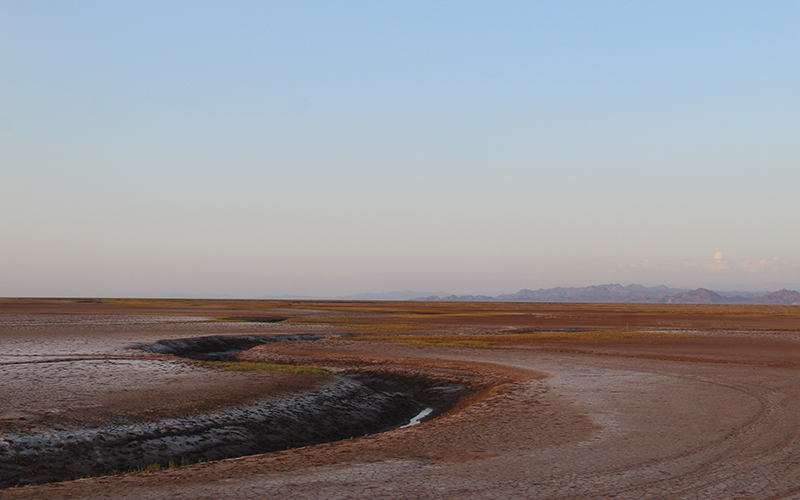
Beavers, which are only active at dawn and dusk, rest in this mid-pond lodge. While their wetland is surrounded by lush grasses and unscathed evergreens, the nearby hillside shows the damage caused by the 2020 Cameron Peak Fire. (Photo by Alex Hager/KUNC)

Beavers have built a home for themselves in Poudre Canyon. This chewed log is just one small piece of a formidable dam. Behind it, a large pond affords beavers protection from predators. (Photo by Alex Hager/KUNC)

A sprawling network of ponds and canals kept the ground saturated even through Colorado’s largest wildfire. Lush grasses persisted even as surrounding hillsides were singed. (Photo by Alex Hager/KUNC)

The Cameron Peak Fire left some hints that it had burned nearby, like these blackened branches poking out of an otherwise verdant meadow. (Photo by Alex Hager/KUNC)
Deep in the Cameron Peak burn scar northwest of Fort Collins, Colorado, nestled among charred hills, lies an oasis of green – an idyllic patch of trickling streams that wind through a lush grass meadow. Apart from a few scorched trees on the periphery, it’s hard to tell this canyon wetland was surrounded by the largest wildfire just more than a year ago.
Credit the industry of beavers.
The semiaquatic rodents, quite famously, dam streams to create a sprawling network of pools and canals that offers safety anywhere within the meadow. Beavers, who can grow to 60 pounds, are clumsy on land, but talented swimmers.
On a recent visit to that patch of preserved land in Poudre Canyon, ecohydrologist Emily Fairfax emphasized the size of the beavers’ canal network. Bleak evidence of the Cameron Peak Fire in 2020, which destroyed 208,913 acres of national forest, is all around.
“Oh my gosh, I can’t even count them,” Fairfax said of the beaver canals. “It’s a lot. There’s at least 10 ponds up here that are large enough to see in satellite images. And then between all those ponds is just an absolute spiderweb of canals, many of which are too small for me to see until I’m here on the ground.”
The infrastructure that gives beavers safety from predators also helps shield them from wildfire. Their work saturates the ground, creating an abnormally wet patch in an otherwise dry area. Dams pool the water, and the channels spread it across a wide swath of valley floor.
Fairfax researches how beavers reshape the landscapes where they live. Across the West, she has seen beaver-created wetlands survive wildfires.
“When you’re at this beaver complex,” she said, “it never stops being green. Everything else in the landscape – the hill slopes on either side, they both charred. They lost all their vegetation during this fire. But this spot, it did not. These plants were here last year and they’re still here today.”
Standing in golden-green grass up to her knees, Fairfax points to a row of trees about 100 feet away, where the trunks have clearly been singed but brown needles still cling to branches – a sign of “moderately intense” burning. One hundred feet past that, another row of trees is completely black – indicating “high intensity” burning.

Emily Fairfax, an ecohydrologist who specializes in beavers, sings the praises of the industrious mammals when it comes to their firefighting ability. She has studied their work across the West, and found many examples of beaver wetlands surviving large wildfires. (Photo by Alex Hager/KUNC)
That gradient, Fairfax said, shows just how effectively the wet beaver meadow held back the fire. These saturated wetlands also serve as a kind of reservoir, slowing down the release of mountain runoff on its way to the places where humans divert and collect it.
“It’s mimicking this critical function that used to be pervasive in these riverscapes,” said Joe Wheaton, a fluvial geomorphologist at Utah State University. “And is that a similar function to what snowpack does or the inefficient movement of water, and that leads to healthier riverscapes.”
As snow does, beaver wetlands hold water for gradual release. That will likely get more important as climate change drives higher temperatures and less snowfall, making high-mountain water storage even more valuable.
The wetland storage system often is bigger than it looks because more than 80% of the water in beaver complexes is underground. But in the grand scheme of things, Wheaton said, those systems don’t store that much water.
“Beaver are not going to be the miracle answer,” he said. “You’re not going to create more water at that sort of scale.”
Although it won’t make a difference for water managers taking a wider perspective, people are noticing significant changes on a small scale – like when an upstream beaver dam lets a rancher get water a bit longer into the season during a drought year.
That isn’t lost on humans, who have tried to reap the benefits of beaver wetlands by creating their own. A budding world of “beaver dam analogs” has seen the strategic creation of human-built dams to help slow the release of water.
Projects across the West have seen some success, but largely haven’t been as effective as the real thing.
“The beaver complex and the beaver wetland is so much more than the dam,” Fairfax said. “It’s the channels, it’s the digging, it’s the chewing, it’s the constantly changing the landscape, the dynamics, the flexibility.”
Beavers have millions of years of practice building dams and shaping waterways, and that makes them capable water managers.
Fairfax did see a beaver complex serve as a fire break one time in Colorado, but she said it’ll take far more research before we can figure out how effective these wetlands are when it comes to slowing wildfires on a large scale. But for now, these areas are surviving as oases of green amid big fires across the West.
This story is part of ongoing coverage of the Colorado River, produced by KUNC, with support from the Walton Family Foundation.
